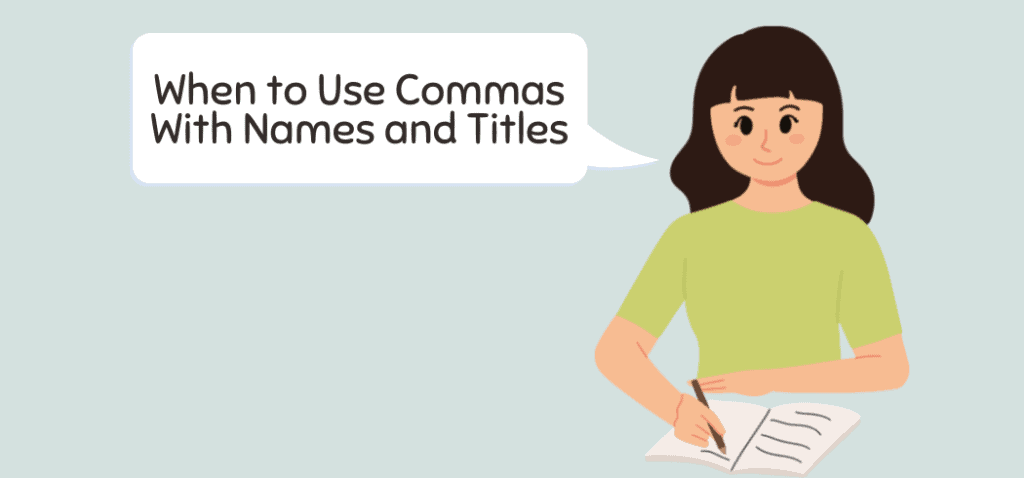Were you once taught that a comma is always used to introduce a person’s name or a title of a work in a sentence?
You were taught incorrectly, and this is one of the most confusing grammar rules for both new and experienced English writers. Although subtle, using commas when they are not needed can create confusing breaks in the flow of your writing, and learning how to use them correctly is important.
Luckily, proper comma usage with names and titles is an easy lesson, as I’ll explain below.
When to Use Commas With Names and Titles

I’m going to make this simple from the start. If you keep the following in mind, you will never have an issue remembering when to use a comma with names or titles.
Unless the name or title is last in a sentence, you will either use a comma both before and after it, or you will use no commas at all.
Let’s review when it is appropriate to use commas and when it is not.
Using Commas Around Names and Titles
Commas rules dictate that they are only used around nonessential clauses. Nonessential clauses are clauses that can be removed from a sentence without affecting the grammar or meaning of a sentence. They may add detail, but that detail is not essential.
When using commas with names and titles, the same idea applies. If the name or title is not necessary to the overall understanding of the sentence, then commas are required.
Two Commas = Nonessential Information
For example:
- There is only one book, The English Patient, I always return to when I want an escape from reality.
In this example, the book title, The English Patient, can be removed without changing the meaning of the sentence (see what I did there?). The writer makes it clear there is only one book, so the addition of the title is not clarifying which book out of many; its addition simply adds detail to the sentence.
- The head chef of The Foxes Brunch restaurant, Michelle Sweeny, began her career while still in High School.
This example also includes a name that is not required since the sentence already indicates there is only one head chef. The chef’s name is an added detail that brings more interest to the sentence, but it is not required. If removed, the sentence still makes perfect sense.
Removing Commas From Around Names and Titles
Including names and titles in order to make sense of a sentence DO NOT require the use of commas.
NO Sense = NO Commas
For example:
- The best person to learn from in that school is instructor Mike Berlyn of St. James, Virginia.
If Mike Berlyn is removed from the sentence, the sentence no longer makes sense. Therefore no commas should be used.
- On September 8, the winning Bay Lightning took the field by six full-lengths.
Similarly, the winning horse’s name, Bay Lightning, is required in this sentence since the removal would make the sentence confused. Therefore no commas should be used.
When Does a Comma Go Before a Name or Title?
If a comma is placed only before a name or title, it is due to the name or title being placed at the end of a sentence.
For example:
- I was excited to finally meet my best friend’s new puppy, Sebastian. He’s supposed to be a Blue Heeler and Border Collie mix.
You might also see a comma placed before a name or title if they are placed at the beginning of an independent clause following an introductory phrase or clause. This is a rule specific to commas and not names or titles.
For example:
- Despite the late hour of the day, Monica knew she was still going to have to go to the store before heading home. The thought exhausted her.
When Does a Comma Go After a Name or Title?
If a comma is placed after a name or title, it is because it is placed in such a manner that it is being used as part of an introductory phrase or clause. This is a comma rule separate from the rules of commas with names and titles and refers to proper grammatical punctuation.
For example:
- I made the phone call to Professor Smyth, hoping he would understand the tardiness of my assignment.
Let’s Review
If you are looking for the answers pertaining to names and titles and comma use, hopefully this article cleared this up.
If you learned that commas always introduce names and titles, you were taught incorrectly. You only use commas around a name or title if they are being used as nonessential details within the sentence. You can check your understanding of this by removing the name or title and seeing if the sentence still makes sense.
Never include commas if the name or title is required for the understanding of the sentence.